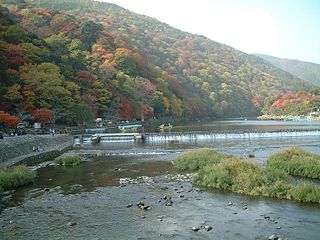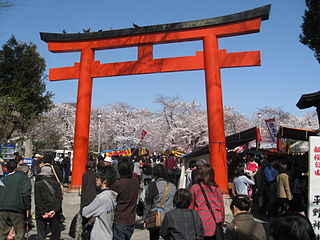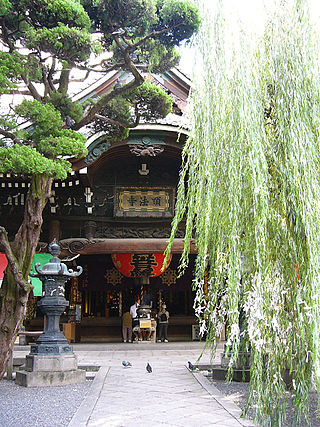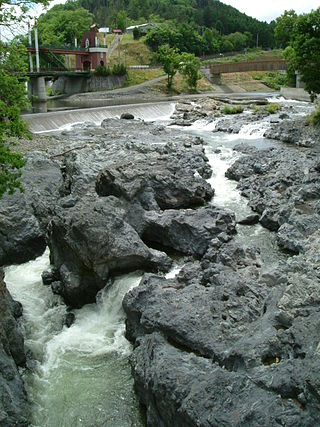Related Research Articles

Enryaku-ji is a Tendai monastery located on Mount Hiei in Ōtsu, overlooking Kyoto. It was first founded in 788 during the early Heian period (794–1185) by Saichō (767–822), also known as Dengyō Daishi, who introduced the Tendai sect of Mahayana Buddhism to Japan from China. The temple complex has undergone several reconstruction efforts since then, with the most significant taking place in 1642 under Tokugawa Iemitsu. Enryaku-ji is the headquarters of the Tendai sect and one of the most significant monasteries in Japanese history. As such, it is part of the UNESCO World Heritage Site "Historic Monuments of Ancient Kyoto ". The founders of Jōdo-shū, Jōdo Shinshū, Sōtō Zen, and Nichiren Buddhism all spent time at the monastery. Enryaku-ji is also the center for the practice of kaihōgyō.

Arashiyama is a district on the western outskirts of Kyoto, Japan. It also refers to the mountain across the Ōi River, which forms a backdrop to the district. Arashiyama is a nationally designated Historic Site and Place of Scenic Beauty.

The Yodo River, also called the Seta River and the Uji River at portions of its route, is the principal river in Osaka Prefecture on Honshu, Japan. The source of the river is Lake Biwa in Shiga Prefecture to the north.

Fushimi Inari-taisha is the head shrine of the kami Inari, located in Fushimi-ku, Kyoto, Kyoto Prefecture, Japan. The shrine sits at the base of a mountain, also named Inari, which is 233 metres (764 ft) above sea level, and includes trails up the mountain to many smaller shrines which span 4 kilometres (2.5 mi) and take approximately 2 hours to walk up. It is unclear whether the mountain's name, Inariyama, or the shrine's name came first.

The Isshi incident was a successful plot by Nakatomi no Kamatari, Prince Naka no Ōe and others who conspired to eliminate the main branch of the Soga clan, beginning with the assassination of Soga no Iruka. It takes its name from the zodiological name of the year 645 during which the Taika Reform, a transformative event in Japanese Imperial history, occurred.

Amanohashidate is one of Japan's three scenic views. The sandbar is located in Miyazu Bay in northern Kyoto Prefecture. It forms part of the Tango-Amanohashidate-Ōeyama Quasi-National Park.

Shijō Street runs in the center of Kyoto, Japan from east to west through the commercial center of the city. Shijō literally means Fourth Avenue of Heian-kyō, the ancient capital.

Daikaku-ji is a Shingon Buddhist temple in Ukyō-ku, a western ward in the city of Kyoto, Japan. The site was originally a residence of Emperor Saga, and later various emperors conducted their cloistered rule from here. The Saga Go-ryū school of ikebana has its headquarters in the temple. The artificial lake of the temple, Ōsawa Pond, is one of the oldest Japanese garden ponds to survive from the Heian period.

Sai-ji or the West Temple was one of the two large Buddhist temples established in Kyoto, Japan.

Sanjō Ōhashi (三条大橋) is a bridge in Kyoto, Kyoto Prefecture, Japan. It spans the Kamo River as part of Sanjō-dōri. It is well known because it served as the ending location for journeying on both the Nakasendō and the Tōkaidō; these were two of the famous "Five Routes" for long-distance travelers during the Edo period in Japan's past.

Gangyō-ji is a Buddhist temple in Kyoto, founded by the priest Henjō. The Emperor Kōkō endowed the temple and the emperor Kazan abdicated in this temple.

Kōryū-ji (広隆寺) is a Shingon temple in Uzumasa, Ukyō Ward, Kyoto, Japan. The temple is also known by the names Uzumasa-dera (太秦寺) and Kadono-dera (葛野寺), and was formerly known as Hatanokimi-dera (秦公寺), Hachioka-dera (蜂岡寺) and Hōkō-ji (蜂岡寺).

Hōkō-ji is a temple in Kyoto, Japan, dating from the 16th century. Toyotomi Hideyoshi determined that the capital city should have a Daibutsu temple to surpass that of Nara. He is reputed to have claimed at the outset that he would complete construction in half the time it took Emperor Shōmu to complete the Great Buddha of Nara. The project during Emperor Shomū's reign took ten years. Hideyoshi would complete the initial phase of his project in only three years. The architects for this project were Nakamura Masakiyo and Heinouchi Yoshimasa.

The Hirano Shrine is a Shinto shrine in Kyoto, Japan. This shrine is known and popular for its gardens and many trees.

Kajū-ji, also sometimes spelled "Kwajū-ji" or "Kanshu-ji, is a Shingon Buddhist temple in Yamashina-ku, Kyoto, Japan.

Sennyū-ji (泉涌寺), formerly written as Sen-yū-ji (仙遊寺), is a Shingon Buddhist temple and head of the Sennyū-ji sect in Higashiyama-ku in Kyoto, Japan. For centuries, Sennyū-ji has been a mausoleum for noble families and members of the Imperial House of Japan. Located within the temple grounds are the official tombs of Emperor Shijō and many of the emperors who came after him.

The Rokkaku-dō, official name Chōhō-ji, is a Buddhist temple in Kyoto, Japan, said to have been established by Prince Shōtoku. The name comes from its main hall's hexagonal shape. This temple is part of the Saigoku Kannon Pilgrimage.

Shokotsu River is a river in Hokkaidō, Japan. It is designated a Class A river by the Ministry of Land, Infrastructure, Transport and Tourism.

Hirose Shrine, also referred to as Hirose-jinja, is a Shinto shrine located in Kawai, Nara prefecture, Japan.
Tsuki no wa no misasagi (月輪陵) is the name of a mausoleum in Higashiyama-ku, Kyoto used by successive generations of the Japanese Imperial Family. The tomb is situated in Sennyū-ji, a Buddhist temple founded in the early Heian period, which was the hereditary temple or bodaiji (菩提寺) of the Imperial Family.
References
- Ponsonby-Fane, Richard A. B. (1956). Kyoto: The Old Capital of Japan, 794-1869. Kyoto: The Ponsonby Memorial Society.